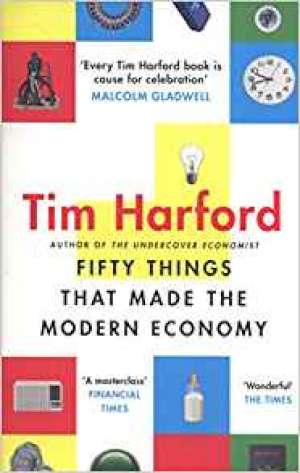20 November 2018
Fifty Things That Made The Modern Economy
Tim Harford
2018, Little, Brown, 352 pages,
ISBN 9780349142630
Reviewer: Sunil Krishnan

Tim Harford has a decent claim to be Britain’s only popular economist. Five bestselling books testify to the breadth of his appeal, and the quantity of his ideas. While it may be interesting to discuss why he has not spurred more imitators, his latest book exemplifies why a country which has “had enough of experts” is happy to come back to one again and again.
“Fifty Things That Made The Modern Economy”, a collection based on his radio series for the BBC World Service, uses a series of unassuming objects and technologies to tell interesting stories about their creators, show how our current commercial and social arrangements rely on small but critical links, or introduce wider debates such as the role of the state in innovation.
This is not “A History Of The Worid In 100 Objects” – another book based on a BBC radio series, but more sweeping in scope, with the omniscient Neil McGregor leaving readers feeling that nothing important was omitted. Harford is nothing if not well-read, but there is something more deliberately arbitrary about his selections; as if to make the point that he could have written another dozen such miscellanies, and still only hinted at the structures that hold up contemporary life.
At times there seems to be a tension between what makes the book accessible and what makes it an economics book. Much of the discussion would find as good a home in an anthropological study – the section ‘Reinventing How We Live’ discusses air conditioning, TV dinners and the Pill – while at times the personal stories of creators or adopters move centre-stage instead of remaining as refreshing asides. Fritz Haber’s story begins with ammonia manufacturing but quickly refocuses on war crimes, patriarchy and exile.
There remains space, though, for a number of illustrations of key economic concepts such as two-part pricing (razor blades) or externalities (the S-bend and sanitation); for introductions to long-standing economic debates such as the necessity of state support for the market economy (the iPhone); and for reminders of how economic life can leave a deep cultural legacy (cuneiform, the earliest known form of writing).
Those looking to understand the structure of the economy specifically are likely to take particular pleasure in the section ‘Ideas About Ideas’, which explains the importance of certain social and technological developments to trade and commerce. Intellectual property protection, for example, is brought to life with the story of steam power and the litigious Boulton and Watt.
Perhaps, though, the roaming brief is the secret of his success and his rarity. To overcome the appearance of aloofness, economists need to show a willingness to borrow from other disciplines, an eye for human interest stories, and a sense of humour. Few of us will have it in us to be the next Harford, but perhaps we might settle for being a little more in touch, and as a result a little more influential.
